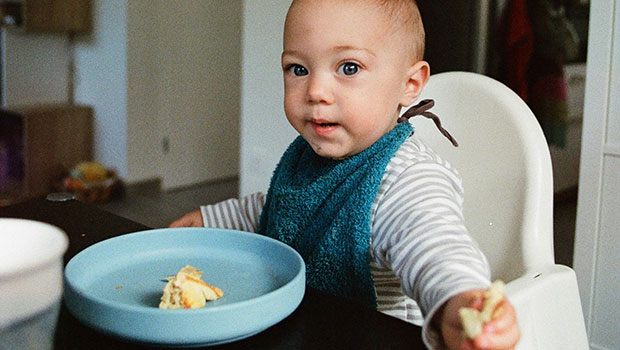You may feel like you just started your weaning journey, but it’s amazing how quickly babies develop. As they grow, what they eat, how they eat it and how much they eat changes. Here, we break down what you can expect to serve your baby for breakfast, lunch and dinner – at different stages of their development.
In Weaning Sense, paediatric dietitian Kath Megaw and occupational therapist Meg Faure refer to three stages of weaning. The Ready stage is when you first start your baby on solids, any time between four and six months. The Steady stage runs from six months to 10 months, and the Go stage is from 10 to 12 months. The guidelines below roughly follow these three stages. At the Steady stage, your child may also be ready for a mid-morning and/or a mid-afternoon snack of a grain or fruit with a protein.
As you start each stage, you may find your baby eats the minimum recommended amount and, as the stage progresses, you’ll want to slowly increase the amount you serve them. Keep in mind, however, that babies will have days or weeks when they eat more or less, so it’s always important to follow your individual baby’s cues.
ALSO READ: What is the COLLAB approach to weaning?
What to serve for breakfast for:
A 6 month old
You can expect a six-month-old baby to eat anything from 1 to 4 tablespoons of porridge and 1 to 4 tablespoons of fruit purée with 2 teaspoons of yoghurt. You can make your own porridge by grinding whole oats, whole barley or brown rice. Add seasonal puréed fruit to the cooked porridge or to full-cream plain yoghurt or serve as is.
A 9 month old
At this stage, your baby will be eating anywhere from 2 tablespoons to ½ cup of porridge in the morning and still 1 to 4 tablespoons of fruit. You can also include 2 tablespoons of full-cream plain yoghurt or another dairy, fat or protein. Weaning Sense has delicious and healthy combinations your baby is sure to love, from “carrot cake” porridge to a vibrant berry-and-beetroot porridge. Fruit doesn’t have to be puréed anymore, but can be grated into porridge or, if the fruit is soft enough, be served in halves for your baby to practise self-feeding.
Click here to buy Weaning Sense for more recipe inspiration.
A 12 month old
At this stage it really is “go, go, go!” when it comes to solids. Give your baby plenty of healthy options and let them take the lead. They should be enjoying 2–8 tablespoons of porridge, 2–6 tablespoons of fruit and 1 tablespoon of yoghurt, or another dairy, fat or protein. Remember this is just a guideline, though, so feel free to offer other healthy options, such as this cheese omelette served with fruit and a slice of toasted wholewheat bread to encourage your baby to self-feed.
What to serve for lunch for:
A 6 month old
For lunch, you can serve 2–6 tablespoons of veggie purée with 1–2 tablespoons of egg, meat, dairy, nuts or legumes. For example, try this spinach, potato and cheddar sauce purée or add butternut purée to scrambled egg or peanut butter.
A 9 month old
For lunch, your baby will still be eating 2–6 tablespoons of vegetables and 1–4 tablespoons of protein, along with 1–2 teaspoons of fat. Try this salmon, peas and sweet potato mash recipe as one option or these gem squash soufflés – both are excellent options to introduce different textures to your baby.
A 12 month old
Lunch should also be a smaller plate of whatever the family usually enjoys. Aim for 1–2 tablespoons of a cooked grain or a slice of bread with 2–6 tablespoons vegetables or salad, a fruit, 1–4 tablespoons protein or dairy, and 1–2 teaspoons fat. Try chicken-wrapped mini frittatas or mini shepherd’s pie for two tasty and healthy options.
What to serve for supper for:
A 6 month old
For supper, serve another 2–6 tablespoons of veggie purée mixed with 1 teaspoon of fat in the form of avocado, coconut oil, a nut butter or dairy. For example, stir cream cheese into puréed gem squash or add breast milk or formula to puréed roasted sweet potato.
A 9 month old
You can start serving a full meal for supper at this stage (albeit a smaller quantity than what you might typically eat). Think 1–4 tablespoons of a good-quality grain, 2–6 tablespoons vegetables, 1–2 tablespoons of protein and 1–2 teaspoons fat. This Moroccan lamb with prunes and millet is a delicious option – you can purée it if your baby still prefers a smoother texture.
A 12 month old
Ideally the whole family will enjoy supper together, so serve a smaller portion of whatever you’re making for the rest of the family – just be sure to reduce the amount of salt you would usually use. (We promise, you soon won’t be able to tell the difference!) Generally, you want to aim for 2–4 tablespoons grains, 4 tablespoons to ½ cup of vegetables, 1–2 tablespoons protein, and 1–2 teaspoons fat. This chicken, leek and mushrooms on couscous recipe is a great option, or try the coconut chicken curry or spicy chickpea and butternut soup in Weaning Sense.
Looking for more delicious weaning recipes? Download the Parent Sense app for age-appropriate recipes and meal plans now!

